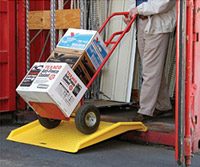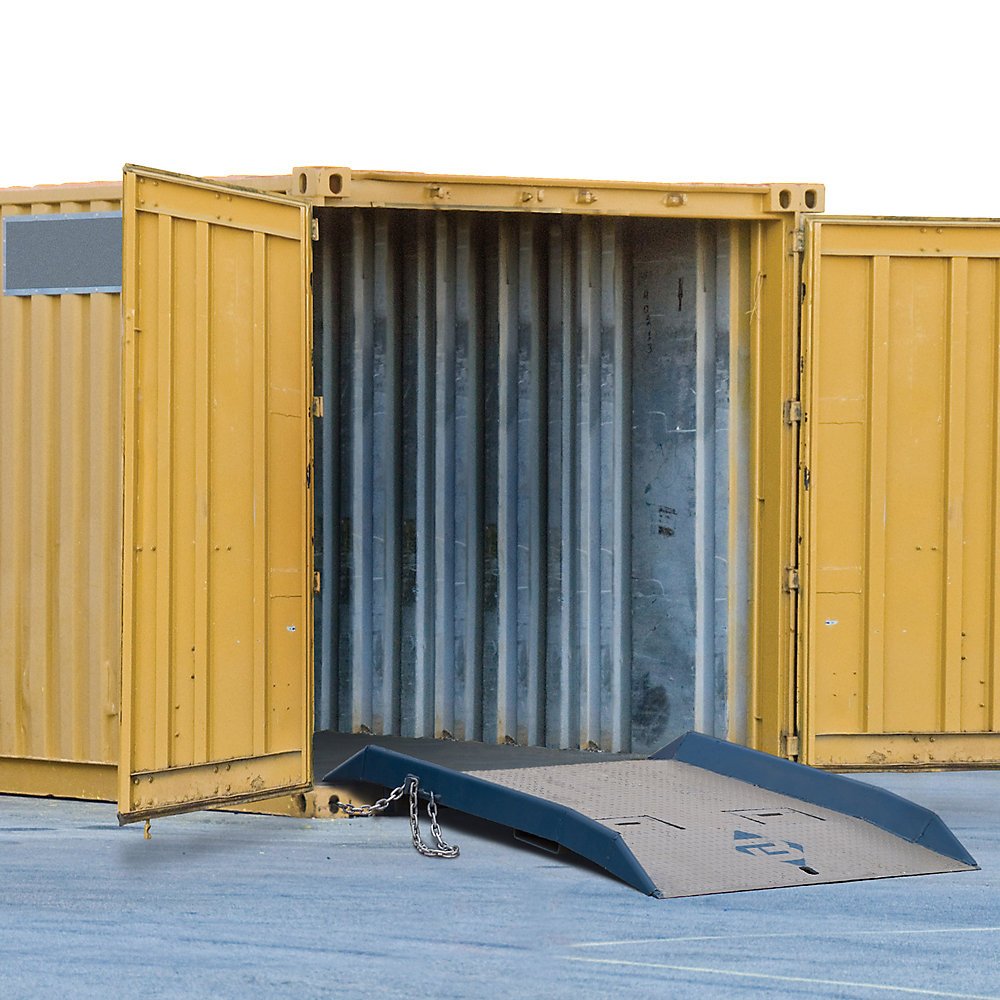Aaron Supreme’s guide to shipping container ramps makes finding the best fit easier. Learn about ramp materials and uses, and utilize our installation steps.

Shipping containers are a perfect option for businesses with extra storage needs, homeowners requiring an alternative to traditional storage facilities, and people looking to design a home quickly and affordably.
While containers offer a solution, they also present a challenge: “How can I transfer items in and out of my container without extensive effort and time?”
The answer is simple: shipping container ramps from us!
Our easy-to-follow guide to shipping container ramps covers everything you need to know. From primary uses to installation and maintenance tips, keep reading to determine which ramp is best for your needs.
What Is a Shipping Container Ramp?
A shipping container ramp is a sturdy structure that serves as a bridge-like connector between a container’s entrance and the ground it’s placed on. The ramp allows goods and machinery to be efficiently loaded and unloaded without increasing the risk of injury to those transferring the items.
They are formed from various materials and designed in sizes and styles that cater to specific needs and weight restrictions. When buying storage containers, consider investing in additional accessories that may be useful, like ramps.
At Aaron Supreme, our high-quality ramps come in various materials:
Steel Ramps
Steel ramps are heavy-duty champs, ideal for industrial settings where you move machinery or pallets loaded with goods.
Weight capacity of steel ramps:
- Residential Grade: 5,000 to 10,000 pounds
- Commercial-Grade: 10,000 to 15,000 pounds
- Industrial-Grade: 20,000+ pounds
Aluminum Ramps
Aluminum ramps are lighter than steel but still incredibly durable. Aluminum ramps are corrosion-resistant and easier to move around.
Weight capacity of aluminum ramps:
- Residential Grade: 2,500 to 5,000 pounds
- Commercial-Grade: 5,000 to 10,000 pounds
- Industrial-Grade: Up to 15,000
Rubber Ramps
Rubber ramps are perfect for lighter loads and offer excellent traction, making them ideal for uses where slippage could be a concern, like shipping container homes or pop-up shops.
Weight capacity of rubber ramps:
- Residential Grade: 1,000 to 2,500 pounds
- Commercial-Grade: 2,500 to 5,000 pounds
- Industrial-Grade: Up to 5,000 pounds
Request a free quote from Aaron Supreme, and we’ll get back to you shortly with more information about our selection of shipping container ramps.
What are Shipping Container Ramps Used For?
The various materials used for shipping container ramps make them versatile. They can support operations across industries, simplify personal storage, and accommodate specific needs.
Industrial and Construction Use
Shipping container ramps are indispensable in industrial and manufacturing settings like factories and warehouses. They optimize for quickly transferring bulky machines, pallets, and substantial quantities of products from the container to the facility.
On construction sites, shipping container ramps are helpful when moving over-sized equipment like bulldozers, excavators, or other heavy machinery to and from containers.
Industrial-grade steel ramps are the first choice for these heavy-duty applications. Industrial-grade aluminum ramps can also work in many industrial settings, but they are less durable and often more expensive than steel ramps.
Retail and Wholesale
Shipping container ramps for retail and wholesale businesses can significantly speed up loading and unloading. They make moving stock in and out easier, reducing the need for added manual labor and increasing efficiency. Commercial-grade steel ramps or industrial-grade aluminum ramps are perfect for retail operations.
Personal Use
If you’re using a shipping container for personal storage, a residential-grade rubber ramp can be a perfect choice. They’re ideal for moving furniture, household items, or small vehicles like ATVs or motorcycles from residential storage containers. Rubber ramps are also easy to install and remove.
Improved Accessibility
Shipping container ramps aren’t just for goods and machinery; they also benefit those who use them. If you’ve converted a shipping container into a living space, office, or retail outlet, a ramp can make it accessible to everyone, including those with mobility issues. Residential-grade aluminum or rubber ramps are often used in these scenarios due to their lower weight capacities.
Specialized Uses
Some ramps are designed for specific uses, such as loading cars or forklifts into containers. These specialized ramps are engineered to handle the unique requirements of these tasks, ensuring safety and ease of use. Both ramps and shipping containers can undergo custom modifications.
How to Install a Container Ramp
Installing a shipping container ramp is a manageable task, but it’s crucial to get it right to ensure safety and functionality.
Practical tips on how to install a container ramp:
- Check the Manual: Review the manufacturer’s manual for special installation instructions.
- Location Safety: Install the ramp on a flat, firm surface, like concrete or packed dirt. Uneven ground can damage the ramp or cause injury to the people using it.
- Two-Person Job: Install the ramp with at least one other person to reduce the risk of injury and speed up the process.
- Weather Conditions: Do not install the ramp during rain or snowfall to avoid slippage and injury.
Equipment needed to install a container ramp:
Protective Gear: Wear gloves, steel-toed boots, and safety goggles. Use a hard hat when installing heavy-duty ramps.
- Pallet Jack or Forklift
- Level
- Measuring Tape
- Chalk
- Anchoring Bolts
- Wrench
Nine steps to install a container ramp:
- Clear the installation site of any obstructions and put on your safety gear.
- Use the pallet jack to position the ramp close to the container. A forklift may be best for heavy-duty steel ramps.
- Use a level to check that the ramp is even. Reposition the ramp as needed.
- Measure and mark the placement of the anchoring bolts on your container.
- If necessary, drill holes in your container for the anchoring bolts.
- Insert the anchoring bolts and tighten them with the wrench.
- Use your level to ensure the ramp is still even after installation.
- Use a light load to perform a safety test.
- Tighten the anchoring bolts if needed.
Maintenance and Cleaning of Ramps
Container ramp maintenance is critical for frequent use, so routine inspections and standard cleanings are necessary to keep your ramp safe. You should wipe away dust or scuff marks, test hinges for proper functioning, and look for cracks or other signs of structural damage.
We’ve Got You Covered
There you have it: a straightforward guide to shipping container ramps and a reliable solution for seamless loading and unloading.
Contact Aaron Supreme today to place your order for a durable container ramp!

